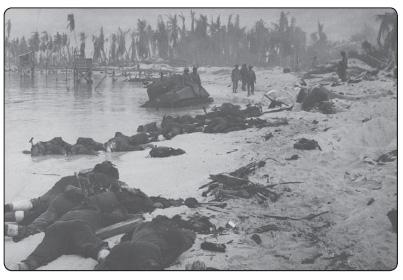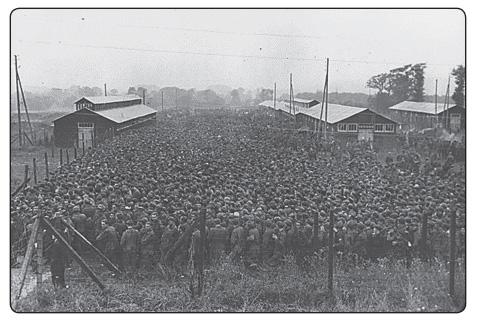The History Buff's Guide to World War II (19 page)
Read The History Buff's Guide to World War II Online
Authors: Thomas R. Flagel

Men stationed in the lush tropics were warned not to forage too readily from the trees. Berries and fruits that were especially colorful, sweet, decorative, low to the ground, or bright tended to be extremely poisonous.

CAUSES OF MILITARY DEATHS
In a war for national defense, soldiers died far away from their country: Poles over Britain, Japanese in Alaska, Brazilians in Italy, Australians in North Africa. Germans died in thirty countries other than the Fatherland.
For the families left behind, the news came belatedly, if at all. U.S. armed forces were among the most efficient in reporting losses, alerting spouses and next of kin within two to four weeks of the event. Dictatorships in general denied military losses while inflating damages done upon the enemy. In the first six months of their invasion of the Soviet Union, some 750,000 soldiers of the Third Reich were killed. Berlin reported losses of 30,000, whereas Moscow claimed to have wiped out an equally fictitious 4 million.
49
Accurate totals will be forever unknown, due primarily to incomplete or destroyed records, multiple causes of death, and the inability of governments (particularly the Soviet Union and Nationalist China) to effectively tabulate catastrophic numbers. Ranked here by descending counts are the ten most prevalent causes of military fatalities during the war. Estimates are conservative. The total exceeds the approximately twenty-five million military fatalities due to overlapping causes.
1
. KILLED IN ACTION (11 MILLION)
By definition KIA meant any fatality that occurred in a combat zone where death came before the body reached an aid station or hospital. For the United States, the Second World War became the second-bloodiest conflict in its history. Yet with 294,597 battle deaths (about 0.2 percent of the population), Americans fared comparatively well. Perhaps a million Japanese died in combat. Two million Germans were killed in action. For every twenty Germans who fell, seventeen did so at the hands of the Soviet army and air force. In achieving this deadly distinction, the Soviets suffered the worst combat losses of any country. Official estimates calculate 5,187,000 dying in hostile action or on the way to aid stations.
50
Numerically the army was the branch hardest hit, accounting for roughly eight of every ten servicemen killed in action. Infantry lost the bulk of these. Constituting just 14 percent of the U.S. armed forces, foot soldiers sustained 70 percent of the casualties, a statistic commensurate with other nationalities. The chief cause was artillery, followed by machine-gun fire, rifle fire, mines, bombs, and grenades.
51
Next highest fatality totals came from the navies, where drowning and fire were principle killers. Work on the high seas had an all-or-none quality. The 1941 sinking of the
Bismarck
left 110 alive out of 2,300, while the HMS
Hood
took a hard salvo from the German battleship and disappeared in seconds, taking all but three of its 1,421 men.
Submarines were proportionally the deadliest service. U.S. submarine losses were 22 percent, Italy 33 percent, Japan more than 50 percent, and Germany more than 70 percent. Deaths came mostly through asphyxiation or implosion. All that was needed was a small fissure of the inner chambers, a failure of pumps, or the breaking of battery acid cells to smother an entire crew.

Scenes like this one on the beach at Tarawa were not unique during six years of fighting.
In the air services, combat was exceptionally lethal. On average, chances of surviving a tour of duty were around 60 percent for fighter pilots (and much lower for Japanese flyers). Air crews in medium bombers had approximately a fifty-fifty chance of seeing the end of the war. Heavy bombers, with little opportunity for evasive action in tight formations, had a survival rate of less than 30 percent.
52
The worst fatality rate in any battle may go to the Japanese at Iwo Jima. Of 23,000 soldiers and sailors guarding the island in February 1945, not more than 250 survived the fight.
2
. UNKNOWN—MISSING IN ACTION (7 MILLION)
With battles transpiring over greater areas and using more destructive weapons than ever before, bodies vanished with alarming frequency.
Water devoured countless casualties. Tides pulled the dead and wounded from amphibious landings into the deep. Plane crews and parachutists sank without a trace in bogs, lakes, and seas. An untold number of Luftwaffe and RAF pilots found their final resting place in the English Channel. Then there were the thousands of lost ships. Half of all USSR navy casualties were categorized as “failed to return from mission.” Land was no better. Plane crashes, collapsing buildings, fires, explosions, and rolling tank treads buried or obliterated the living.
53
Nearly 80,000 Americans were eventually designated as MIA, officially declared as dead a year after their disappearance. German records listed more than 1.3 million missing, most of whom were probably Soviet prisoners, with only 11,000 declared dead in the war. In keeping with Stalin’s policy, 4.5 million Soviets were ranked as simply missing when assuredly the majority were prisoners.
54
As there were names without bodies, there were also bodies without names. Essentially every unknown soldier was a member of the missing found without tags, documentation, or enough of their person left to make a positive identification.
One MIA turned up in 1974 quite alive. Lt. Onoda Hiroo of the Imperial Japanese Army remained armed and hidden on Lubang Island in the Philippines until persuaded to give himself up.
3
. PRISON (6 MILLION)
The 1929 G
ENEVA
C
ONVENTION
standardized the treatment of prisoners, but the experiences of World War II POWs were anything but consistent. Detained all over the world, captives lived and died in extremes of heat and cold. Some ate well while others starved. Some were held in isolation while others were packed tight in compounds and ship hulls. A few were released in days; many never were.
Death came in a myriad of ways. Survival depended mainly on the ideological and racial policies of the host. Upon entering a German camp, a British detainee had about a 95 percent chance of living, whereas a Russian’s prospects were a grim 35 percent. In Japanese captivity, one out of four British died while perhaps nine out of ten Chinese perished. On the sixty-five-mile Bataan Death March of April 1942, Japanese soldiers murdered an average of ten Americans every mile and ten Filipinos every two hundred yards.
55
Overall, nationalities developed an unspoken practice of mutual response. Few Japanese ever surrendered, preferring to die rather than face the “shame” of capitulation. Allied soldiers, spurred by frequent incidents of Imperial brutality against captives, were only too ready to kill rather than capture Japanese. Germans and Americans exchanged atrocities in the 1944 campaign across France; these usually involved twenty to forty slaughtered prisoners. In the Nazi-Soviet dance of death, the Red Army captured more than three million Germans. About half died. Germans captured nearly six million of the Red Army. More than half of them perished.
56
Almost universally, belligerents refused prisoner exchanges for fear of replenishing their enemy. Only ten transfers occurred in the European theater between 1942 and 1944, mostly involving at-risk medical cases, totaling twenty thousand Axis for twelve thousand Allies. The Soviet Union was extremely reluctant to repatriate captives. Moscow kept many German soldiers until 1957. Of nearly six hundred thousand Japanese taken prisoner by the Soviets in the final weeks of the war, half were still unaccounted for in 1970.
57

Overcrowding was the least of a prisoner’s worries, as disease, hunger, and guards could kill on a daily basis.
In September 1941, Russians were dying in several Nazi prison camps at the pace of 1 percent every twenty-four hours, a rate three times worse than the American Civil War POW camp of Andersonville.
4
. DIED OF WOUNDS (4 MILLION)
“Died of wounds” is defined as sustaining mortal injuries in a combat zone and later dying in a medical facility.
Few events misshape the human form with as much grotesque variation as battle, and devices brought to the Second World War seemed exceptionally adept. Yet in many cases, subjects continued to live for many hours, days, sometimes weeks after undergoing mortal deformation. A German soldier on the eastern front recalled walking among Russian prisoners, “many of whom had been badly burned by flame throwers…. Their faces had no longer any recognizable human features but were simply swollen lumps of meat. Another had his jaw shot away.”
58
Survival depended heavily on how one was wounded. Damages to the head and neck were the most lethal. A distant second was trauma to the chest, followed by the abdomen, and lastly extremities. Access to treatment was vital. Wounded commandos and airborne troops, who frequently operated behind enemy lines, survived less often than artillerymen in the rear echelons.
The deciding factor appeared to be to which country an individual belonged. In every company the U.S. had three medics; the Japanese had one. British nationals enforced hygiene with iron discipline in nearly every theater, whereas Russians rarely had the supplies to address the issue. Canadian and U.S. medical teams were among the best equipped with the latest innovations; the Germans had not yet perfected the manufacture of dried plasma or penicillin.
59
As the war progressed, deaths among the wounded increased for the Axis and decreased among the Allies, primarily because the latter controlled more and more of the sea, land, and air routes along which patients, pharmaceuticals, and food traveled.
60
Yet on average, medical advances were saving the wounded three times more often than in the previous century. Consequently, a greater percentage of men were able to go right back into the fold. The Red Army calculated it had more than twenty-seven thousand soldiers who were wounded on seven or more separate occasions and returned to duty. The Third Reich actually had a military decoration for soldiers wounded ten or more times.
61
